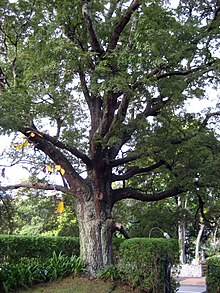Nothofagus solandri, commonly called black beech, is species of tree endemic to New Zealand. Black beech occurs on both the North and the South Island at low elevations up to the mountains. It is also known as Nothofagus solandri var.solandri. In New Zealand the taxon is often called Fuscospora solandri.[3]
| Nothofagus solandri | |
|---|---|

| |
| Scientific classification | |
| Kingdom: | Plantae |
| Clade: | Tracheophytes |
| Clade: | Angiosperms |
| Clade: | Eudicots |
| Clade: | Rosids |
| Order: | Fagales |
| Family: | Nothofagaceae |
| Genus: | Nothofagus |
| Subgenus: | Nothofagus subg. Fuscospora |
| Species: | N. solandri
|
| Binomial name | |
| Nothofagus solandri | |
| Synonyms[2] | |
| |
Black beech is a medium-sized evergreen tree growing to 27 m tall. The leaves are oppositely arranged, ovoid, 10 mm long and 5 mm broad, with smooth margins.
Black beech is known as black beech because it is prone to a sooty mold which covers the trunk and branches. This, in turn, is the result of a scale insect which sucks sap from the tree, and excretes honeydew, a sweet liquid, in small droplets (less than 1 mm diameter) on the end of stalks. This feeds the sooty mold, and also forms a valuable high-energy food source for various birds and insects including the kaka. The infestation is common and does not appear to harm the tree.
Black beech and mountain beech have both been planted in Great Britain, and mountain beech has shown better cold tolerance than black beech in locations such as Scotland.[4]
Hybrids
edit- Black beech is known to hybridise freely with mountain beech (Nothofagus cliffortioides) where the two species co-exist. Mountain beech generally grows at higher elevations than black beech. In some places the hybrids may form complex introgressive hybrid swarms.[5]
- Black beech hybridises with hard beech (Nothofagus truncata) to form the hybrid species Nothofagus × apiculata.[3]
- Black beech hybridises with red beech (Nothofagus fusca) to form the hybrid species Nothofagus × dubia.[3]
References
edit- ^ Baldwin, H. (2018). "Nothofagus solandri". IUCN Red List of Threatened Species. 2018: e.T96478358A96479990. Retrieved 26 May 2022.
- ^ Nothofagus solandri (Hook.f.) Oerst. Plants of the World Online. Retrieved 21 April 2023.
- ^ a b c HEENAN, PETER B.; SMISSEN, ROB D. (2013). "Revised circumscription of Nothofagus and recognition of the segregate genera Fuscospora, Lophozonia, and Trisyngyne (Nothofagaceae)". Phytotaxa. 146 (1): 131. doi:10.11646/phytotaxa.146.1.1. Retrieved 31 May 2015.
- ^ "Nothofagus solandri in Great Britain".
- ^ "Fuscospora solandri". New Zealand Plant Conservation Network. Retrieved 31 May 2015.
External links
edit- Media related to Nothofagus solandri at Wikimedia Commons
- Data related to Nothofagus solandri at Wikispecies
- University of Waikato: Nothofagus
